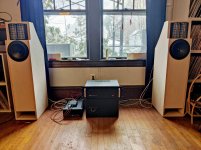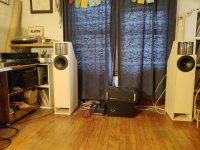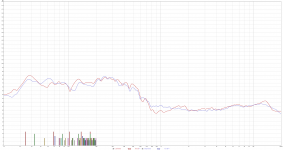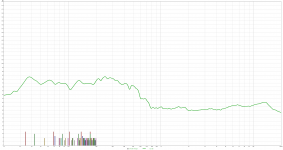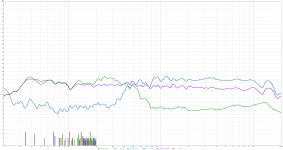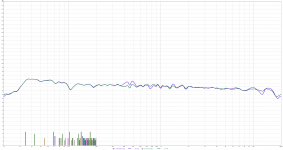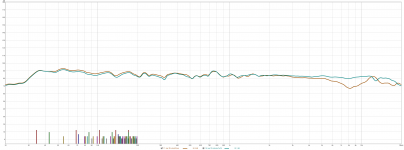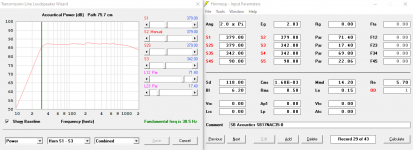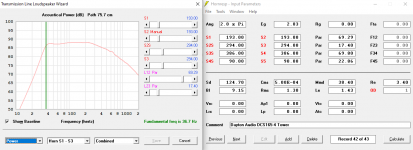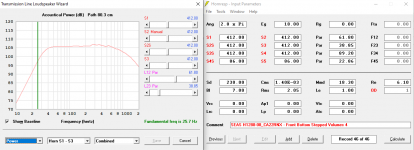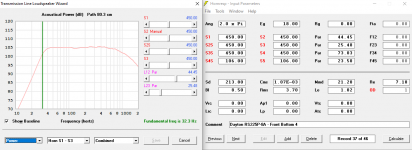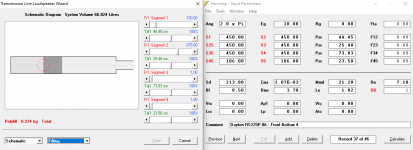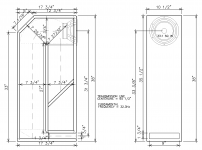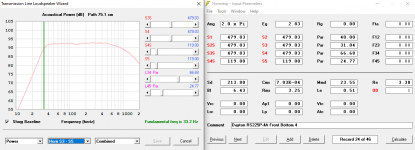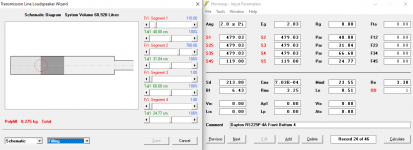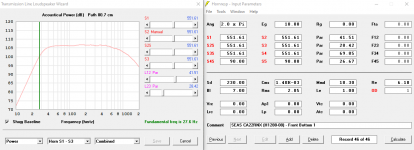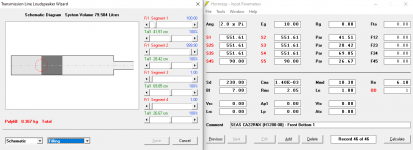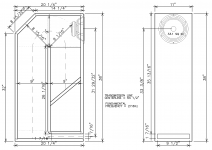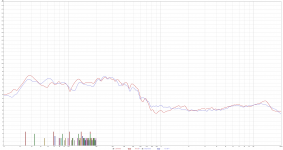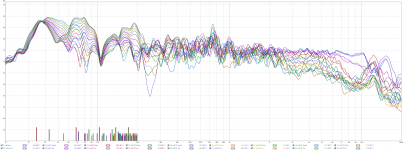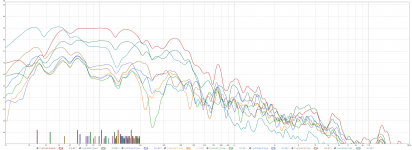Thanks! I have both speakers fully operational! I couldn't be happier with their sound - open, clear, and effortless. I will look at redoing the DSP EQ filters in the miniDSP 2x4 HD after they have played for a while.
I think having the sides of the tweeters exposed has let them disappear. The listening position center has widened considerably.
These are much more dynamic than with the 8 ohm woofer in the LT1000 cabinet, and they are at once, delicate and powerful.
I think having the sides of the tweeters exposed has let them disappear. The listening position center has widened considerably.
These are much more dynamic than with the 8 ohm woofer in the LT1000 cabinet, and they are at once, delicate and powerful.
Attachments
Last edited:
I will post some REW measurements. I am using an active crossover, that uses PEQ from a measurement. (Hence to two amplifiers.) The in-room measurement I used for that is on the listening axis at about 1 meter.
I will try to do some nearfield woofer and port measurements.
I will try to do some nearfield woofer and port measurements.
I reworked the crossover today, to do it more thoroughly (measuring both speakers and averaging) and I increased the electronic crossover point on the tweeter up to 480Hz. There was more summing when both the woofer and the tweeter were set to 440Hz, even with the 48dB/octave Linkwitz Riley slopes.
Here are the measurements I took, at listening axis at about 1 meter from each speaker. The first is both woofers, and the second is the woofer average. I think the dip centered at about 105Hz is a floor cancellation.
The third is the woofer and tweeter averages, and the left and right speaker average - with the driver PEQ filters applied.
The fourth is the left and right average, and then the average of both with the overall PEQ filter applied. They sound as good as this looks. 🙂
I will try to do some nearfield woofer and terminus opening measurements.
Here are the measurements I took, at listening axis at about 1 meter from each speaker. The first is both woofers, and the second is the woofer average. I think the dip centered at about 105Hz is a floor cancellation.
The third is the woofer and tweeter averages, and the left and right speaker average - with the driver PEQ filters applied.
The fourth is the left and right average, and then the average of both with the overall PEQ filter applied. They sound as good as this looks. 🙂
I will try to do some nearfield woofer and terminus opening measurements.
Attachments
Last edited:
I made nearfield measurements today - and I have to say, they look very good, indeed. The first image is the average nearfield measured response of both woofers, and both openings. (Almost touching the phase plug and just at the center of the opening.)
The response is amazingly smooth, and very close to the target "room curve" of flat between 200Hz and 1kHz, and a 0.7dB/octave rise below 200Hz. Remember the woofer in crossed over at 440Hz with a 48dB/octave LR slope.
The woofers are hitting the *exact* fundamental frequency predicted in Hornresp. If anything, the predicted response curve is conservative, but the fundamental frequency is nead dutz. The opening adds on below this - the speakers are virtually flat to at least 30Hz, and only another 3-4dB down at 20Hz! Pretty sweet for an 8" woofer.
The surprising thing to me, is the opening follows very closely to the woofer all the way up to ~700Hz and falls off more steeply above that. Should I put some "eggcrate" foam on the back and/or bottom inside the cabinet?
The second image is two measured responses that average the left and right speakers, on the listening axis. One is at the height about midway between the center of the woofer and the center of the tweeter - essentially level with the step/shelf under the tweeter. The other is about 3" higher, at the center of the tweeter - this lacks the trough from 6-12khZ.
The response is amazingly smooth, and very close to the target "room curve" of flat between 200Hz and 1kHz, and a 0.7dB/octave rise below 200Hz. Remember the woofer in crossed over at 440Hz with a 48dB/octave LR slope.
The woofers are hitting the *exact* fundamental frequency predicted in Hornresp. If anything, the predicted response curve is conservative, but the fundamental frequency is nead dutz. The opening adds on below this - the speakers are virtually flat to at least 30Hz, and only another 3-4dB down at 20Hz! Pretty sweet for an 8" woofer.
The surprising thing to me, is the opening follows very closely to the woofer all the way up to ~700Hz and falls off more steeply above that. Should I put some "eggcrate" foam on the back and/or bottom inside the cabinet?
The second image is two measured responses that average the left and right speakers, on the listening axis. One is at the height about midway between the center of the woofer and the center of the tweeter - essentially level with the step/shelf under the tweeter. The other is about 3" higher, at the center of the tweeter - this lacks the trough from 6-12khZ.
Attachments
Last edited:
I have been trying out some more tuning in Hornresp, based on what I have been hearing and measuring with the pair of cabinets I have built. The main thing I think I have learned is, that the fundamental frequency predicted by Hornresp is spot on, while the response curve at the bottom end is a bit conservative. In other words, it seems like Hornresp shows a response rolloff above the fundamental frequency, but in what I measured was flatter / more linear down to the fundamental frequency.
And, I have gone back an figured the peak power level for the two Dayton Audio woofers, to model them at their maximum output, right at either their displacement limit, and then reduced the S4S and S5 areas (the height of the last segment and the opening), to get as low a fundamental frequency as possible, and still stay close to no more than 10m/sec for the mouth velocity.
And I have gotten the fundamental frequencies to 27.6Hz for the 4 ohm woofer, and 25.7Hz (!!) for the 8 ohm. The reason the 8 ohm is lower is that I need the cabinet to be a bit taller, because it is using the 1.5" high tweeter; whereas the 4 ohm in using the 6" high tweeter. So the 8 ohm is in a 2" taller cabinet, and it has a *slightly* narrower opening.
The new openings are 1.25" x 8.5" (68.55cm2) for the 4 ohm and 1.125" x 8.5" (61.69cm2) for the 8 ohm. And the mouth velocity is about 10-11 m/sec at about 105dB output at 20Hz, which will essentially never happen.
The Eg voltages I am using are 12V for the 4 ohm (~44 watts) and 18V for the 8 ohm (~46 watts).
And, I have gone back an figured the peak power level for the two Dayton Audio woofers, to model them at their maximum output, right at either their displacement limit, and then reduced the S4S and S5 areas (the height of the last segment and the opening), to get as low a fundamental frequency as possible, and still stay close to no more than 10m/sec for the mouth velocity.
And I have gotten the fundamental frequencies to 27.6Hz for the 4 ohm woofer, and 25.7Hz (!!) for the 8 ohm. The reason the 8 ohm is lower is that I need the cabinet to be a bit taller, because it is using the 1.5" high tweeter; whereas the 4 ohm in using the 6" high tweeter. So the 8 ohm is in a 2" taller cabinet, and it has a *slightly* narrower opening.
The new openings are 1.25" x 8.5" (68.55cm2) for the 4 ohm and 1.125" x 8.5" (61.69cm2) for the 8 ohm. And the mouth velocity is about 10-11 m/sec at about 105dB output at 20Hz, which will essentially never happen.
The Eg voltages I am using are 12V for the 4 ohm (~44 watts) and 18V for the 8 ohm (~46 watts).
Two Woofers Compared The 6" SB Acoustics SB17NAC35-8 vs the 6.5" Dayton Audio DCS175-4
Both have smooth response, but the SB Acoustics has a lower fundamental frequency and is flat to 1kHz.
The Dayton Audio has much higher Mms 39.5g vs 14.8g My opinion is that lower moving mass is always going to be better.
The Fs are similar: 32Hz for the SB, and 35.7Hz for the Dayton.
Both have smooth response, but the SB Acoustics has a lower fundamental frequency and is flat to 1kHz.
The Dayton Audio has much higher Mms 39.5g vs 14.8g My opinion is that lower moving mass is always going to be better.
The Fs are similar: 32Hz for the SB, and 35.7Hz for the Dayton.
Attachments
The Dayton DCS-165 is designed for subwoofer duty, so it isn't really a fair comparison. The higher Mms is likely as a result of its heavier coil (slightly greater Xmax, higher power-handling).
Right, except the SB Acoustics does lower bass, too. In fact, of the models that I have tried, this driver has the deepest fundamental frequency that still has an essentially flat response curve.
Last edited:
So, I think I have found my new favorite 8" woofer, for a 2-way design - the SEAS H1288-08 CA22RNX. It is a coated paper cone - that has a very low Mms of just 20.9g. It has an Fs of 29Hz, and a Qts of 0.41. Fantastic specs - and it has a very open frame and the spider is open. Their response graph shows ~4-5dB peak at ~3kHz, so it is very good, but not perfect. Madisound sells it for $94: SEAS Prestige CA22RNX (H1288) 8" Coated Paper Cone Woofer That is half again as much as the Dayton Audio RS225P, but I think still very reasonable.
Here's the Hornresp model response I got. The fundamental frequency is 25.7Hz, and this is the best response that I have seen. I can't see how this speaker could need a subwoofer, and I think it's low Mms means it will do bass detail midrange very well.
Here's the Hornresp model response I got. The fundamental frequency is 25.7Hz, and this is the best response that I have seen. I can't see how this speaker could need a subwoofer, and I think it's low Mms means it will do bass detail midrange very well.
Attachments
Last edited:
Maximized MLTL for Dayton Audio RS225P-8A
After working on a version of this design for a SEAS woofer, I learned a couple things, and this is the result with the Dayton Audio RS225P-8A woofer - it is slightly wider and deeper than the one I built. But the response is very flat and the fundamental frequency is 32.3Hz vs 36.2Hz. It is straight except for the last segment.
Here's the CAD drawing - the closed end is significantly shorter than before. The angled stop panel should prevent some standing waves.
I might increase the height of the opening to fit in eggcrate foam, and keep the same open area. The pair I built, just got the eggcrate foam today, and I like it so far. I will measure the opening output, and see if the high frequencies coming out of the opening, are knocked down, and if the fundamental frequency is lowered at all.
After working on a version of this design for a SEAS woofer, I learned a couple things, and this is the result with the Dayton Audio RS225P-8A woofer - it is slightly wider and deeper than the one I built. But the response is very flat and the fundamental frequency is 32.3Hz vs 36.2Hz. It is straight except for the last segment.
Here's the CAD drawing - the closed end is significantly shorter than before. The angled stop panel should prevent some standing waves.
I might increase the height of the opening to fit in eggcrate foam, and keep the same open area. The pair I built, just got the eggcrate foam today, and I like it so far. I will measure the opening output, and see if the high frequencies coming out of the opening, are knocked down, and if the fundamental frequency is lowered at all.
Attachments
Last edited:
Maximized MLTL for Dayton Audio RS225P-4A with Linaeum TLS Tweeter
Here is the maximized version of the cabinet for the 6" high Linaeum tweeter - since the tweeter is taller, the cabinet is 2" shorter. So it had to be a bit deeper, to get the internal volume up a bit. The response is ever so slightly different than the taller cabinet with the 8 ohm woofer; and the fundamental frequency is also slightly higher.
The height of the opening is a touch taller - and if I decide to make room for the 1.5" eggcrate foam, then it will increase by about 3/4" (which is the thickness at the thinnest part of the foam).
This increased 1/2" in width, and 2 3/4" in depth vs the cabinets I built. For that, the response is virtually flat and the fundamental frequency dropped 3.5Hz.
Here is the maximized version of the cabinet for the 6" high Linaeum tweeter - since the tweeter is taller, the cabinet is 2" shorter. So it had to be a bit deeper, to get the internal volume up a bit. The response is ever so slightly different than the taller cabinet with the 8 ohm woofer; and the fundamental frequency is also slightly higher.
The height of the opening is a touch taller - and if I decide to make room for the 1.5" eggcrate foam, then it will increase by about 3/4" (which is the thickness at the thinnest part of the foam).
This increased 1/2" in width, and 2 3/4" in depth vs the cabinets I built. For that, the response is virtually flat and the fundamental frequency dropped 3.5Hz.

Attachments
Revised SEAS CA22RNX MLTL Model & CAD Drawing
After I reworked the Dayton versions, I made some more adjustments to the SEAS version - it is now flatter and smoother response, but the fundamental frequency is now 27.6Hz. Still very impressive, I have to say, for an 8" woofer.
I have drawn the cabinet - it is a large enclosure, but I was going for the maximum performance. I will be laying out the panels - hopefully they all still fit on a single 5'x5' sheet of Baltic birch plywood.
After I reworked the Dayton versions, I made some more adjustments to the SEAS version - it is now flatter and smoother response, but the fundamental frequency is now 27.6Hz. Still very impressive, I have to say, for an 8" woofer.
I have drawn the cabinet - it is a large enclosure, but I was going for the maximum performance. I will be laying out the panels - hopefully they all still fit on a single 5'x5' sheet of Baltic birch plywood.
Attachments
The angled stop panel should prevent some standing waves.
Given the frequencies involved, and that the volume fill has already removed the HF stuff that would be affected by the relatively small diference in pipe length caused by the angled bit, but it will not hurt, and as a brace, angled is good.
dave
I have been using REW to do a running FFT as I am listening to music, and I am seeing the dips in the bass and midbass. So the ~100-200Hz mainly, and the 45-60Hz range as well.
Any suggestions as to what these could be caused by? Or thoughts on how to figure out what might be causing them?
Any suggestions as to what these could be caused by? Or thoughts on how to figure out what might be causing them?
Attachments
Last edited:
I think the suck-out at 100Hz can be the vent working as a Helmholtz resonator
It is like a 5" tube with 10.5" length which is resonant with the Volume at this frequency.
As a TL the length indicates a fundamental of 46.9Hz with 140Hz and 234Hz and 327Hz ... eigenfrequencies
This might cause the peaks
It is like a 5" tube with 10.5" length which is resonant with the Volume at this frequency.
As a TL the length indicates a fundamental of 46.9Hz with 140Hz and 234Hz and 327Hz ... eigenfrequencies
This might cause the peaks
I think the suck-out at 100Hz can be the vent working as a Helmholtz resonator
It is like a 5" tube with 10.5" length which is resonant with the Volume at this frequency.
As a TL the length indicates a fundamental of 46.9Hz with 140Hz and 234Hz and 327Hz ... eigenfrequencies
This might cause the peaks
Okay, thanks. I did a bunch of measurements today, and the dip is at about 106Hz, and it appears in all the vertical axis measurements - starting at the midpoint between the tweeter and the woofer, and went up and down in 4" increments up to 32".
I also did nearfield measurements from the woofer center down to the opening center, in 4" increments - and there is a dip in each of those are about 134Hz.
Attachments
- Home
- Loudspeakers
- Full Range
- An Improved Transmission Line Alignment
